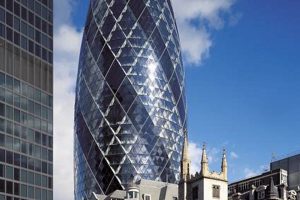A skyscraper’s foundation is a crucial component that ensures the stability and safety of the structure. It is the base upon which the entire building rests and is responsible for transferring the weight of the skyscraper to the underlying soil or bedrock.
The foundation of a skyscraper is typically made of reinforced concrete or steel and is designed to withstand the immense weight of the building above. It is also designed to resist lateral forces such as wind and seismic activity. In addition to providing structural support, the foundation also serves to anchor the skyscraper to the ground and prevent it from sinking or settling.
The type of foundation used for a skyscraper depends on a number of factors, including the height and weight of the building, the soil conditions at the site, and the local building codes. Some of the most common types of foundations used for skyscrapers include spread footings, pile foundations, and caisson foundations.
Spread footings are the most common type of foundation used for low-rise buildings. They consist of a wide, reinforced concrete slab that is placed directly on top of the soil. Pile foundations are used for taller buildings and are made of long, steel or concrete piles that are driven into the ground. Caisson foundations are used for very tall buildings and are made of large, steel or concrete cylinders that are sunk into the ground.
The foundation of a skyscraper is a critical element that ensures the safety and stability of the building. It is a complex and challenging engineering feat that requires careful planning and execution.
1. Types
The foundation of a skyscraper is critical to its stability and safety. The type of foundation used depends on a number of factors, including the height and weight of the building, the soil conditions at the site, and the local building codes.
- Spread Footings: Spread footings are the most common type of foundation used for low-rise buildings. They consist of a wide, reinforced concrete slab that is placed directly on top of the soil. Spread footings are suitable for buildings with a relatively low weight and where the soil conditions are good.
- Pile Foundations: Pile foundations are used for taller buildings and are made of long, steel or concrete piles that are driven into the ground. Pile foundations are used when the soil conditions are not suitable for spread footings, such as in areas with soft or loose soil. The piles transfer the weight of the building to the underlying bedrock.
- Caisson Foundations: Caisson foundations are used for very tall buildings and are made of large, steel or concrete cylinders that are sunk into the ground. Caisson foundations are used when the soil conditions are very poor, such as in areas with very soft soil or water. The caissons are sunk to a depth where they reach bedrock or a stable soil layer.
The type of foundation used for a skyscraper is a critical decision that affects the safety and stability of the building. Engineers must carefully consider the height and weight of the building, the soil conditions at the site, and the local building codes when selecting the type of foundation to use.
2. Materials
Reinforced concrete and steel are the two most common materials used in the construction of skyscraper foundations. Reinforced concrete is a composite material made of concrete and steel reinforcing bars. The concrete provides compressive strength, while the steel reinforcing bars provide tensile strength. This combination of materials makes reinforced concrete an ideal material for skyscraper foundations, as it is strong, durable, and relatively inexpensive.
Steel is also a strong and durable material, but it is more expensive than reinforced concrete. Steel is often used in the construction of skyscraper foundations when the soil conditions are poor or when the building is very tall. Steel piles can be driven deep into the ground to reach a stable soil layer, and steel caissons can be sunk into the ground to create a stable base for the foundation.
The choice of materials for a skyscraper foundation is a critical decision that affects the safety and stability of the building. Engineers must carefully consider the height and weight of the building, the soil conditions at the site, and the local building codes when selecting the materials to use.
3. Purpose
The foundation of a skyscraper serves several critical purposes, including providing structural support, anchoring the building to the ground, and preventing sinking or settling. These purposes are essential for ensuring the safety and stability of skyscrapers, which are some of the tallest and heaviest structures in the world.
- Structural support: The foundation of a skyscraper must be strong enough to support the immense weight of the building above. The foundation transfers the weight of the building to the underlying soil or bedrock, preventing the building from collapsing.
- Anchoring: The foundation of a skyscraper must also be able to anchor the building to the ground and prevent it from overturning. This is especially important in areas with high winds or seismic activity. The foundation provides a stable base for the building, preventing it from swaying or toppling over.
- Preventing sinking/settling: The foundation of a skyscraper must also be able to prevent the building from sinking or settling into the ground. This is important for maintaining the stability of the building and preventing damage to the structure. The foundation distributes the weight of the building evenly across the soil or bedrock, preventing the building from sinking or settling unevenly.
The foundation of a skyscraper is a critical component of the building’s overall design and construction. It is essential for ensuring the safety and stability of the building, and it must be carefully designed and constructed to withstand the forces of nature and the weight of the building above.
4. Design
The design of a skyscraper’s foundation must take into account the immense weight of the building above, as well as the lateral forces that can be exerted on the building by wind and seismic activity. These forces can cause the building to sway or topple over if the foundation is not strong enough to resist them.
- Weight: The weight of a skyscraper is transferred to the ground through the foundation. The fou
ndation must be strong enough to support this weight without sinking or settling. The weight of the building is distributed evenly across the foundation to prevent uneven settling. - Wind: Wind can exert significant lateral forces on a skyscraper. The foundation must be designed to resist these forces and prevent the building from swaying or overturning. This is especially important for skyscrapers in areas with high winds.
- Seismic activity: Seismic activity can also exert significant lateral forces on a skyscraper. The foundation must be designed to resist these forces and prevent the building from collapsing in the event of an earthquake. This is especially important for skyscrapers in areas with seismic activity.
- Other factors: In addition to weight, wind, and seismic activity, the design of a skyscraper’s foundation must also take into account other factors, such as the soil conditions at the site and the local building codes.
The design of a skyscraper’s foundation is a complex and challenging task. Engineers must carefully consider all of the forces that can be exerted on the building and design a foundation that is strong enough to resist these forces and keep the building safe and stable.
5. Factors
The design and construction of a skyscraper’s foundation are influenced by several key factors, including the height and weight of the building, the soil conditions at the site, and the local building codes.
- Height/weight of building: The height and weight of the building are major factors in determining the type and depth of the foundation required. Taller and heavier buildings require stronger and deeper foundations to support their weight and resist lateral forces such as wind and seismic activity.
- Soil conditions: The soil conditions at the site also play a crucial role in foundation design. Different soil types have varying bearing capacities, which determine the amount of weight they can support. Foundations must be designed to transfer the weight of the building to the soil in a way that prevents excessive settlement or collapse.
- Building codes: Local building codes establish minimum standards for the design and construction of foundations. These codes are based on factors such as the seismic zone, wind loads, and soil conditions in the area. Foundations must comply with these codes to ensure the safety and stability of the building.
These factors are closely interconnected and must be carefully considered in the design and construction of a skyscraper’s foundation. Engineers must analyze the specific characteristics of the building and site to determine the most appropriate foundation type and design. By taking these factors into account, engineers can ensure that the foundation provides a solid and stable base for the skyscraper, ensuring its safety and longevity.
6. Importance
The foundation of a skyscraper is paramount to its safety, stability, and longevity. It bears the immense weight of the structure and ensures its ability to withstand various external forces. Without a strong and well-designed foundation, a skyscraper would be vulnerable to collapse or severe structural damage.
The safety of a skyscraper is directly dependent on the integrity of its foundation. A sturdy foundation prevents the building from sinking, tilting, or collapsing under its own weight or external pressures. It acts as a buffer against strong winds, earthquakes, and other natural disasters, safeguarding the lives of occupants and preventing catastrophic events.
The stability of a skyscraper is also crucial for its long-term performance. A well-constructed foundation ensures that the building remains upright and stable over time, preventing excessive swaying or movement that could compromise its structural integrity. This stability is essential for maintaining the functionality and comfort of the building, as well as for preventing premature deterioration.
The longevity of a skyscraper is directly tied to the quality of its foundation. A solid foundation protects the building from the damaging effects of moisture, soil erosion, and other environmental factors that can degrade its structural components. By providing a stable and protective base, the foundation ensures that the skyscraper can endure the test of time and remain a valuable asset for generations to come.
In conclusion, the foundation of a skyscraper is a critical element that underpins its safety, stability, and longevity. It is the cornerstone upon which the entire structure rests, ensuring its resilience and ability to withstand the challenges of time and nature. Understanding the importance of a strong foundation is essential for designing, constructing, and maintaining skyscrapers that are safe, stable, and enduring.
7. Engineering
The engineering involved in designing and constructing the foundation of a skyscraper is complex and challenging. Engineers must consider a multitude of factors, including the height and weight of the building, the soil conditions at the site, and the local building codes. They must also design the foundation to withstand lateral forces such as wind and seismic activity.
One of the biggest challenges in engineering a skyscraper foundation is the need to transfer the weight of the building to the ground in a way that prevents the building from sinking or settling. This is especially important in areas with soft or unstable soil conditions. Engineers must carefully analyze the soil conditions at the site and design the foundation accordingly.
Another challenge is designing the foundation to withstand lateral forces such as wind and seismic activity. These forces can cause the building to sway or topple over if the foundation is not strong enough to resist them. Engineers must use sophisticated computer models to analyze the potential forces that the building may be subjected to and design the foundation accordingly.
Despite the challenges, engineers have developed a number of innovative techniques for designing and constructing skyscraper foundations. These techniques have allowed us to build some of the tallest and most iconic buildings in the world.
The engineering of skyscraper foundations is a complex and challenging field, but it is also a vital one. The safety and stability of skyscrapers depend on the quality of their foundations. Engineers must have a deep understanding of soil mechanics, structural engineering, and wind engineering in order to design and construct skyscraper foundations that are safe and reliable.
8. Examples
The Burj Khalifa, Empire State Building, and Shanghai Tower are three of the tallest buildings in the world. Each of these buildings has a unique foundation that is designed to support its immense weight and withstand the forces of nature.
- Burj Khalifa: The Burj Khalifa is the tallest building in the world, standing at over 828
meters tall. Its foundation is made of reinforced concrete and steel, and it extends 50 meters below the ground. The foundation is designed to support the building’s weight and to resist the high winds that are common in Dubai. - Empire State Building: The Empire State Building is one of the most iconic buildings in the world. Its foundation is made of concrete and steel, and it extends 20 meters below the ground. The foundation is designed to support the building’s weight and to resist the high winds that are common in New York City.
- Shanghai Tower: The Shanghai Tower is the second tallest building in the world, standing at over 632 meters tall. Its foundation is made of reinforced concrete and steel, and it extends 50 meters below the ground. The foundation is designed to support the building’s weight and to resist the high winds and earthquakes that are common in Shanghai.
These three examples illustrate the importance of a strong foundation for skyscrapers. The foundation must be able to support the weight of the building and to resist the forces of nature. Without a strong foundation, a skyscraper would not be able to stand tall and withstand the elements.
FAQs on Skyscraper Foundations
This section addresses frequently asked questions about the foundations of skyscrapers, providing clear and informative answers to common concerns and misconceptions.
Question 1: What are the different types of foundations used for skyscrapers?
Skyscrapers utilize various foundation types depending on factors like building height, weight, soil conditions, and local building codes. Common types include spread footings for low-rise buildings, pile foundations for taller buildings, and caisson foundations for extremely tall structures or unstable soil.
Question 2: Why is the foundation of a skyscraper so important?
The foundation is crucial for the safety and stability of the skyscraper. It bears the immense weight of the building, transfers it to the ground, and resists lateral forces like wind and seismic activity, ensuring the structure’s integrity and preventing collapse.
Question 3: How deep do skyscraper foundations go?
The depth of a skyscraper’s foundation depends on the building’s height, weight, and soil conditions. Foundations can extend several meters below the ground, reaching stable bedrock or soil layers that can adequately support the structure’s load.
Question 4: What materials are used to construct skyscraper foundations?
Reinforced concrete and steel are the primary materials used in skyscraper foundations. Reinforced concrete provides compressive strength, while steel reinforcing bars enhance tensile strength. Steel is also used in pile and caisson foundations to penetrate deep into the ground or through unstable soil layers.
Question 5: How do engineers design foundations to withstand earthquakes and strong winds?
Engineers employ sophisticated computer models to analyze potential forces on the building and design foundations accordingly. They incorporate features like deep foundations, shear walls, and energy dissipation systems to resist lateral forces, ensuring the building’s stability during seismic events and high winds.
Question 6: What are some examples of innovative foundation designs for skyscrapers?
The Burj Khalifa utilizes a reinforced concrete mat foundation with piles extending deep into the ground, while the Shanghai Tower employs a hybrid foundation combining concrete piles and a reinforced concrete raft. These innovative designs showcase the engineering ingenuity in creating stable foundations for the world’s tallest structures.
In conclusion, skyscraper foundations are critical for the safety and stability of these towering structures. Engineers carefully consider various factors to design and construct foundations that can withstand the immense weight and lateral forces acting on the building. Understanding the importance and complexities of skyscraper foundations is essential for appreciating the remarkable feats of modern architecture and engineering.
Transition to the next article section: Exploring the Architectural Marvels of Skyscrapers
Tips for Designing and Constructing Skyscraper Foundations
Skyscraper foundations are complex and challenging engineering feats. By following these tips, engineers can design and construct foundations that are safe, stable, and durable.
Tip 1: Carefully analyze the soil conditions.
The soil conditions at the site will have a major impact on the design of the foundation. Engineers must carefully analyze the soil conditions to determine the bearing capacity of the soil and the potential for settlement. This information will help them to select the most appropriate type of foundation for the building.
Tip 2: Use high-quality materials.
The materials used in the construction of the foundation will have a major impact on its strength and durability. Engineers should use high-quality concrete and steel to ensure that the foundation is strong enough to support the weight of the building and resist the forces of nature.
Tip 3: Design the foundation to resist lateral forces.
Skyscrapers are subjected to lateral forces such as wind and seismic activity. The foundation must be designed to resist these forces and prevent the building from collapsing. Engineers can use a variety of techniques to resist lateral forces, such as shear walls, moment frames, and outriggers.
Tip 4: Consider the long-term performance of the foundation.
The foundation of a skyscraper must be able to withstand the forces of nature and the weight of the building over the long term. Engineers should consider the potential for settlement, corrosion, and other factors that could affect the long-term performance of the foundation.
Tip 5: Get expert advice.
The design and construction of a skyscraper foundation is a complex and challenging task. Engineers should consult with experts in the field to ensure that the foundation is safe, stable, and durable.
Summary:
By following these tips, engineers can design and construct skyscraper foundations that are safe, stable, and durable. These foundations will help to ensure that skyscrapers can withstand the forces of nature and provide a safe and comfortable environment for occupants.
Transition to the article’s conclusion:
Skyscraper foundations are a critical part of these iconic structures. By understanding the importance of skyscraper foundations and following the tips outlined in this article, engineers can design and construct foundations that will ensure the safety and stability of these towering structures for generations to come.
Conclusion
The foundation of a skyscraper is a critical component that ensures the safety and stability of the structure. It is the base upon which the entire building rests and is responsible for transferring the immense weight of the skyscraper to the underlying soil or bedrock. A well-designed and constructed foundation provides a solid and secure base for the skyscraper, allowing it to withstand the forces of nature and the test of time.
In this article, we have explored the different types of foundations used for skyscrapers, the materials they are made of, and their importance in ensuring the safety and stability of these towering structures. We have also discussed the engineering challenges involved in designing and constructing skyscraper foundations and provided tips for engineers to follow to ensure the long-term performance of these foundations.
As skyscrapers cont
inue to push the boundaries of height and design, the importance of a strong and reliable foundation becomes even more critical. Engineers and architects must continue to innovate and develop new techniques to design and construct foundations that can support these massive structures and ensure the safety of their occupants.
The foundation of a skyscraper is a testament to the ingenuity and engineering prowess of humankind. It is a hidden masterpiece that plays a vital role in the safety and stability of these iconic structures. By understanding the importance of skyscraper foundations and the engineering challenges involved, we can appreciate the remarkable feats of modern architecture and engineering.







